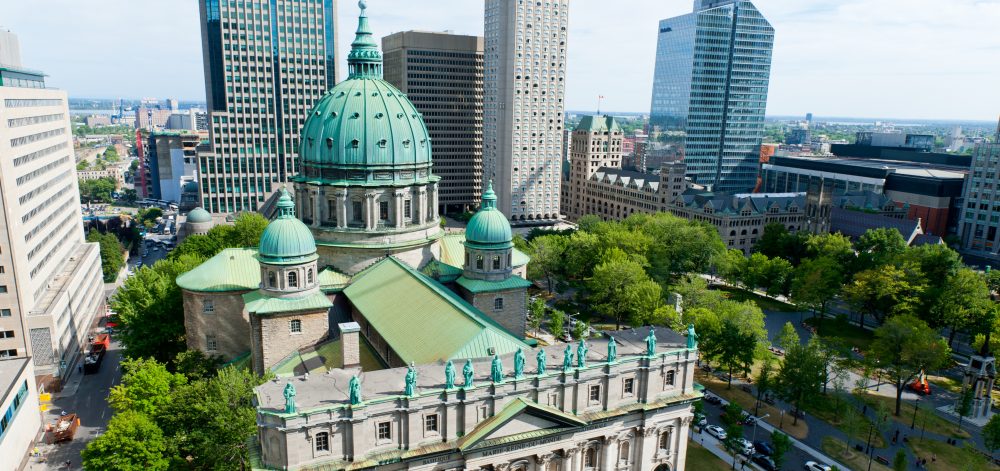French Canada is surely one of the spookiest and most interesting places to visit in all of North America. I went to Quebec City for my honeymoon--in December, at which time that part of the world has already been deep in winter for a month and is covered with several feet of snow. Once we got there, though I believe the high temperature during the entire 4-5 days was around -5 degrees, it was a wonderful place, but after we left the town where we live, which has around 40,000 people there was not another one even 1/2 that size until we got to Quebec City--7 hours away. I thought it would be a good idea to drive all the way up route 3 to the top of New Hampshire and go to Quebec on the provinical roads from there. The border crossing there is a little hut with one guy in it. At that time (1997) I dont think they even bothered to staff it at night. It is in the mountains so of course everything was buried in snow. They dont even bother to plow the roads there but pack it down with steamroller type machines. Fortunately there was not a blizzard that day, nor did the car break down, because that would likely have been the end of both me and my lovely and adventurous bride. The road maps indicated that there were towns every ten miles or so, La Patrie and Scotstown being the first two on that route, I believe. These "towns" are basically the places where another road intersects with the route that is a continuation of US 3, with a handful of buildings--all darkened as I recall--clustered near the corners right up against the road. Mostly this way is all woods, that time of year it gets dark about 3:30 or 4pm, and of course the temperature outside was easily -20. After about an hour of this we came to one of these intersections where something actually had a light on, which turned out to be a small store. This place is at least fifty miles from anything, and I mean anything. It is the darkest, coldest place I have ever been to. It is in fact so dark on the road, with no indication (i.e. signage) that the road actually leads anywhere, and the surface of it buried under a foot of packed snow, that I became half-worried it was just going to suddenly end deep in the middle of a forest with my gas gauge on E. We decided to stop at the store. Now I knew theoretically that once we entered Quebec we would be among French-speaking people, but I must admit, I do not generally identify French-speaking people with frigid, remote, dark, gloomy mountainous outposts in a Godforsaken part of Canada. Yet there it was. French music was playing on the radio. All the labels and newspapers and food products were entirely in French, though the U.S. was not more than 30-40 miles away. There was a girl working there who was probably about 19, with a classic horsey French girl face, and the long brown hair like a horse's too that goes with it, but thin and vivacious enough that one was moved to wonder what in the world she was doing in that place. I was certain when we drove off back into the pitch dark woods that that there was something cruel in having left her there all alone, or that if we were to turn around and go back the place, like Brigadoon, would have disappeared.
I am going to confess that it is often our habit when we go to Montreal and other places in Canada to stay in the youth hostels, which are well set up to accomodate families there. I find this to be the case in Scandanavia and Britain outside of London as well, that certain hostels (usually the official HI-affiliated ones) have nearly as many families with young children as rowdy backpacker types in them. Of course we have a certain affection for rowdy backpacker types too, some of whom still, I was rather astounded to find, aren't actually all that much younger than I am. Besides being cheaper than a Motel-6 or Holiday Inn type place, the atmosphere is considerably cheerier and encouraging for interacting, or at least making eye contact with the other guests, which is less oppressive to me, and I assume must have some positive effect on the children. The Montreal hostel has a very good little cafe as well, with good music (such as cool, cosmopolitan people listen to--I don't try this at home), interesting pictures, games, etc. It gives the children something to do when they wake up at 7am besides watch television in the room, which I would invariably have them do at an ordinary hotel so I wouldn't have to get my morose patoosie out of bed until the day was half spent.
I have not been to Montreal yet, I don't think, when it was not precipitating in some manner, so we have mostly been relegated to indoor activities there. We seem to like the Biodome, which is housed in one of the arenas built for the 1976 Olympics. It contains, in divisions of the building, a tropical rain forest, a typical Quebec/Vermont/Maine, etc type of temperate forest, and a sub-polar/polar area, the deep polar areas being behind glass in refrigerated compartments, I suppose, in which various fish, birds and small animals live. There are about 100 penguins living in one of these refrigerated areas, which is furnished with rocks, ice and a swimming area, just like home. The penguins are the star attraction of the Biodome. This place is very popular with the family crowd, as you can imagine, French Canadians I suppose loving to gawk at displays of live exotic beasts as much as anyone else does.
Montreal is the best city for churches, certainly for big, grand churches, that I have been to in North America, though the Northeast U.S. (yes New York City, I have not forgotten to honor you) has more really beautiful small churches, and not merely of the waspy white clapboard variety either, than I think is generally realized. The churches in Montreal of which I have been so enamored, are all by the highest standards rather gaudy, over the top French Catholic affairs, though not unlike such later (and iconic) French churches as Lourdes or Sacre-Coeur. I am by immediate ancestry an old Catholic myself, of Irish-Lithuanian descent (is there a more underachieving combination to be found among the nations of Europe? These peoples between them can't even produce a contender for the papacy) , having even been Christened in the Church by my young parents before my father got up the fire to live in the open antagonism to all religion and religious people that animated his true spirit. I suppose this ancestral memory however induces a certain affection for the particular kind of architecture and ornamentation that is characteristic of these churches. The Basilica of Notre Dame, known for its blue ceiling, is an old favorite, though there is nothing austere about it. The interior, with its candles, softly-lit pipe organ, densely packed lavish altars and sculptures and stained glass and gorgeous dark woodwork of the pulpits, pews and balconies produces a feeling as much like being in a library or a dining club from which to come in out of the cold and take a pleasant doze (sitting upright of course) as it does a place for serious religious exercises, though I of course am none the less grateful for its existence.
The Oratoire-St-Joseph, however, on the Mont Royal hill, is the most all out Catholic experience in town, and an extremely moving place to wander about for the afternoon, even for one whose ego is as wary, intellect is as skeptical, and spirit is as estranged from the powers of real religious faith as mine collectively are. The complex was founded in 1904 by the much beloved local divine Brother Andre, to whom were attributed extraordinary healing powers (this is the kind of place that has rack after rack of old, abandoned crutches lining the walls of the chapels), and who was beatified in 1982. The place is enormous, built on an incredibly steep hill with zillions of steps and a gigantic dome with lots of different things to look at, many of them on an over the top scale, some of a more pointed religious nature than others. I really love it. I will try to describe some of the essence of this place by enumerating some of the highlights.
1.The Votive Chapel--10,000 candles, many of them red, interspersed with hundreds of crutches and canes left behind by supposedly healed cripples.
2.Brother Andre`s tomb--You cannot have a shrine without one, of course. To illustrate the importance of this, I have known many people who believed Lincoln was actually buried under the floor of the Lincoln Memorial in Washington (he isnt), for whom the discovery of the absence of the great man`s bones diminished greatly for them the emotional power of the monument. I had never heard of Brother Andre before so I paid my respects from a respectful distance, but other people were kneeling and very fervently gripping the sarcophagus and praying. It was quite intense.
3. The Crypt Church--Mass was actually in progress. Service, hymns in French. Very beautiful.
4. Scale Model of the Shrine--You have to be good to pull off this kind of entertaining stuff and still offer a first-rate religious experience. They are. Which brings us to...
5. Concourse Hall/Terrace on the Roof--After taking the elevator to the 3rd floor (2nd floor off limits to visitors, offices, etc) we can go to the bathroom, buy soft drinks, postcards, rosaries, etc, and then wander out to the terrace, which has a panoramic view of the city on a clear day, which we did not have. They have some of those binocular device-things set up as if you were at Niagara Falls or the Empire State Building. Large granite surface for the children to run around on.
6. Some rooms in honor of Brother Andre (includes wax figure)--His heart is also preserved and on display in a little hexagonal container. Pilgrims often stop and pray before this heart.
7. The Way of the Cross--This is an outdoor garden with statues and a pool intended for meditation and prayer. As absolute silence is required and we had our rambunctious children with us, we had to skip this part of the complex. Overall the Oratory is quite welcoming of children (They are Catholics)
8. The Museum--76 more wax figures from the Bible, plus some religious paintings and sculpture. Is this great or what?
9. The Basilica--I.E, the main church. Completed in the 50s, has a very Vatican II atmosphere about it. Still, by now youre in the mood for anything.
10. 2 more chapels, Brother Andre`s room, and the Pilgrim`s Pavilion (i.e. the main gift shop). Wow.
The church in the picture above is the city`s cathedral, Marie-Reine-du-Monde. I have not been inside but the building is quite striking at street level. The facade and the apostles on the roof are of course taken from the Vatican but the sides have the fat round towers and turrets of a medieval French chateau, which is a good look.
In Montreal the English college has quadrangles and statues of Queen Victoria and neo-gothic Oxfordian style halls while the French college down the street has these chateauesque towers and buildings with steep Norman roofs and is surrounded by a stone wall that resembles a medieval fortification. I thought this was rather humorous.





No comments:
Post a Comment